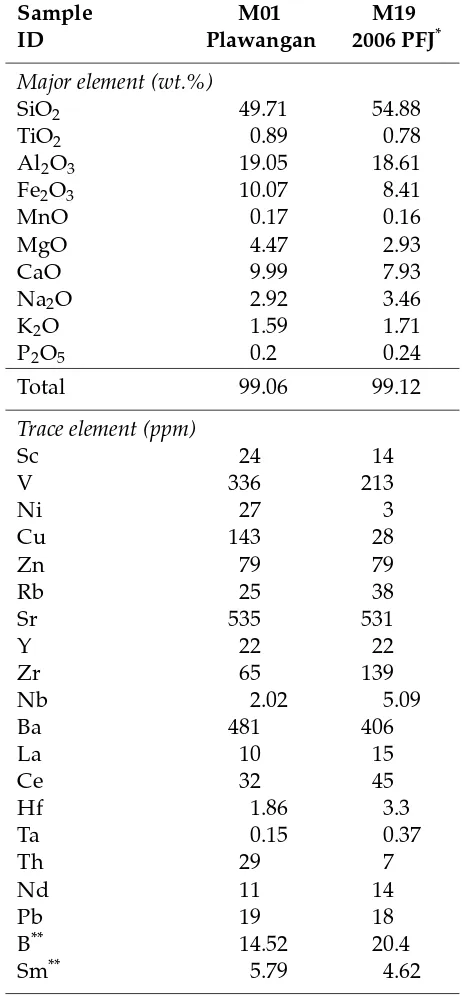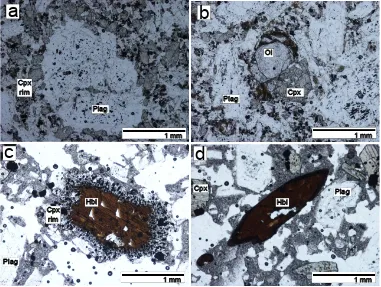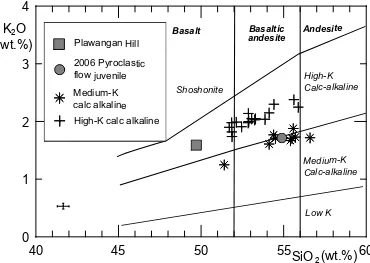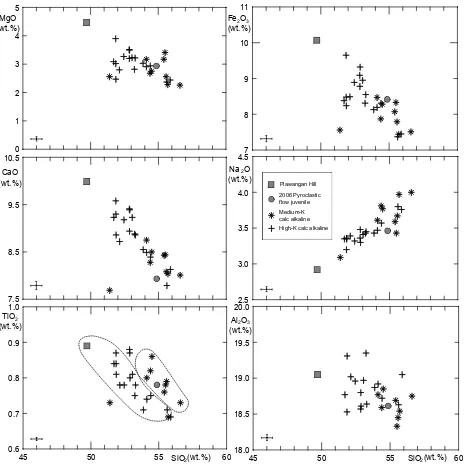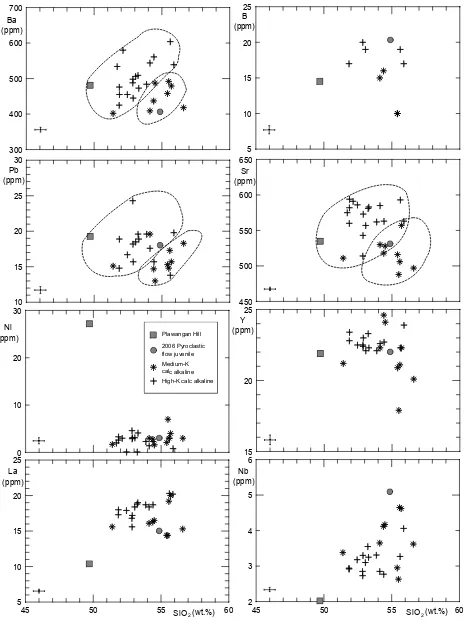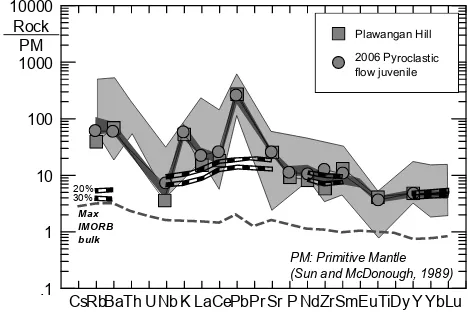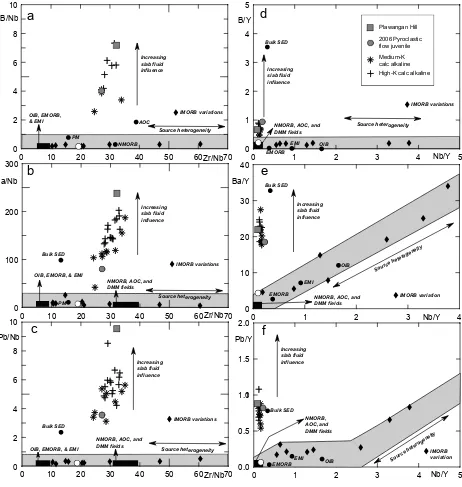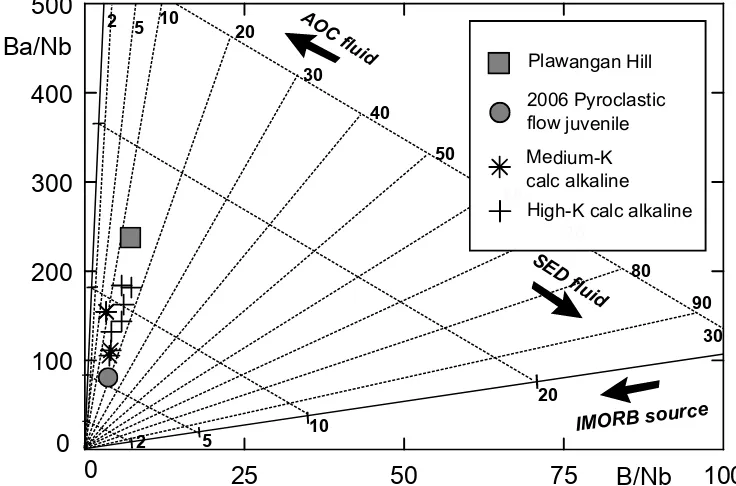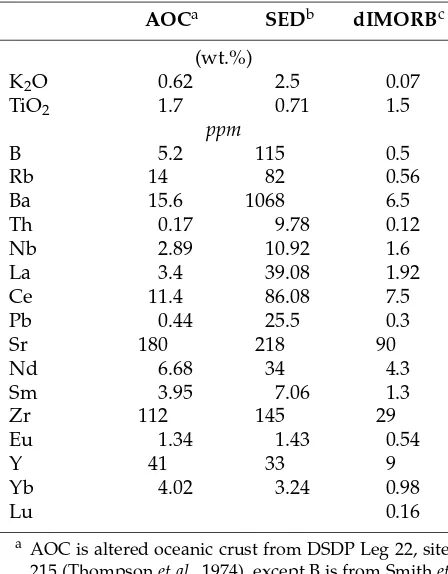DOI: http://dx.doi.org/10.22146/jag.30253
Variation of Slab Component in Ancient and Modern Merapi Products: A
Detailed Look into Slab Derived Fluid Fluctuation over the Living Span of
One of the Most Active Volcanoes in Sunda Arc
Esti Handini*1, Toshiaki Hasenaka1, Agung Harijoko2, and Yasushi Mori3
1Kumamoto University, 2-39-1 Kurokami, Chuo-ku, Kumamoto-shi, 860-8555, Japan
2Department of Geological Engineering, Faculty of Engineering, Gadjah Mada University, Yogyakarta, Indonesia 3Kitakyushu Museum of Natural History and Human History, 2-4-1 Higashida, Yahatahigashi-ku, Kitakyushu, 805-0071, Japan
ABSTRACT. Holocene eruptions of Merapi have produced both medium-K and high-K calc alkaline series which correspond to products older and younger than 1900 years re-spectively. The change has been attributed to increasing sediment input as the volcano matures. This study presents two Merapi samples which represent Ancient and Modern Merapi. The two samples are analyzed for subduction components including B, Ba, Sr, and Pb using X-ray fluorescence (XRF) spectrometer and prompt gamma ray analysis (PGA). Our finding shows that Ancient Merapi sample from Plawangan Hill lava is close in affini-ties with younger than 1900 years high-K magma series. On the other hand, Modern Mer-api sample from 2006 eruption juvenile is plotted within medium-K magma series which are observed in eruption products older than 1900 years. Ratios of fluid mobile elements to high field strength element (HFSE) (i.e. B/Nb, Ba/Y, Pb/Nb) consistently show that An-cient Merapi sample has higher input of slab derived fluid than Modern Merapi sample. A model using B/Nb and Ba/Nb suggests that Plawangan magma requires 1.5 % of sedi-ment derived fluid, higher than estimated in 2006 eruption magma (1.2 %) and medium-K series magma, and within the range of high-K series magma, to explain its slab component enrichment. This evidence suggests that slab derived component addition to the sub-arc mantle wedge highly fluctuates over short period of evolution of a volcano. One possible explanation is the presence of veined hydrous metasomatized sub-arc mantle as Merapi magma source which allows melting of different mantle area to produce fluctuation of slab components in the course of evolution of Merapi magmas.
Keywords: Boron·Slab component·Slab derived fluid contribution·Ancient and
Mod-ern Merapi·Sunda arc.
1 INTRODUCTION
Minor addition of fluids from subducting slab to the mantle wedge, either from altered oceanic crust (AOC) or from its overlying sediment (SED) or both, has been considered as an im-portant factor that shapes geochemical charac-teristics of arc magmas (Whitford and Jezek, 1982; Teraet al., 1986; Vroon et al., 1993, 2001; Ishikawa and Nakamura, 1994; Turner and
Fo-*Corresponding author: E. HANDINI, Kumamoto Uni-versity, 2-39-1 Kurokami, Chuo-ku, Kumamoto-shi, 860-8555, Japan. E-mail: [email protected]
den, 2001; Gertisser and Keller, 2003a,b; Hanyu
et al., 2012). Slab components are elements
1999; Sano et al., 2001). Elliott (2003) suggests that Pb, for example, is abundant in marine SED, while Ba and Sr are abundant in AOC. Boron is specifically abundant in subducting SED more than in AOC (Morris et al., 1990; Ishikawa and Nakamura, 1993; Ishikawa and Nakamura, 1994; Ryan et al., 1995; Smithet al., 1995; Sanoet al., 2001). Accordingly, slab com-ponent is a convenient proxy to evaluate slab derived fluid contribution to the mantle wedge in a magmatic arc.
Previous studies have suggested that Holocene eruptions of Merapi have produced both medium-K and high-K calc alkaline se-ries (Andreastuti, 1999; Gertisser and Keller, 2003a,b). Furthermore, Gertisser and Keller (2003b) recognize that the medium-K series corresponds to samples older than 1900 years, while the high-K series corresponds to samples younger than 1900 years. They suggest that the older than 1900 years medium-K magma series requires less input from subducting sed-iment than the younger than 1900 years high-K magma series. This result implies that subduct-ing sediment input increases as the volcano matures.
This study focuses on two samples whose ages are well defined. One sample is taken from Plawangan Hill lava which represents An-cient Merapi while the other sample is a juvenile of 2006 pyroclastic flow deposit which repre-sents Modern Merapi. The finding of this study shows that Ancient Merapi sample is plotted in high-K calc-alkaline field which corresponds to eruption products younger than 1900 years. On the other hand, Modern Merapi sample is plot-ted within the medium-K calc-alkaline magma series which corresponds to eruption products older than 1900 years. The two samples pro-vide estimation of how slab component changes in a wide span of evolution of a volcano in an island arc setting. Our findings suggest that slab derived fluid contributions highly fluctu-ate and change of slab input at a same level of Wadati -Benioff zone appears to be more fre-quent than it is thought. This rate of changes in slab components can be explained using veined mantle model where slab-derived component is concentrated in veins in the hydrous metaso-matized mantle. Partial melt of different area of this veined mantle may produce Ancient
and Modern Merapi magmas which show rapid fluctuation of slab components.
2 GEOLOGY OFMERAPIVOLCANO
Merapi is the Quaternary volcanic front of cen-tral section of Sunda arc, Java Island, Indonesia, and corresponds to 180 km depth of Wadati Be-nioff zone. This volcano, dubbed as the most active volcano in Indonesia, has erupted a wide range of magma compositions.
3 SAMPLE ANDMETHOD
The two samples in this study are presented in Table 1. Sample M01 is a lava flow from Plawangan Hill, representing Ancient Merapi. Sample M19 is a juvenile of June 2006 pyroclas-tic flow (Figure 1). Lava and pyroclaspyroclas-tic sam-ples from Holocene Merapi reported by Ger-tisser and Keller (2003b) are also used for com-parison. In order to minimize the uncertainty of different measurements between analyzed and published samples, standard error of sample is presented as error bars in Figure 3, Figure 4, and Figure 5. The standard error (SE) is calculated using formula SE = SD/√(N), where SD is standard deviation andNis the number of mea-surements.
Major and trace elements of the two sam-ples were determined with a Philips PANalyt-ical MagiX PRO XRF spectrometer using 1:5 dilution glass beads at the Kitakyushu Mu-seum of Natural History and Human History, following the calibration method of Mori and Mashima (2005). Boron concentration is ana-lyzed by prompt gamma ray (PGA) analysis at the thermal neutron beam guide JRR-3M reac-tor using the facility described in Yonezawaet al.(1992) and Yonezawa and Wood (1995), at the Japan Atomic Energy Agency (JAEA) laborato-ries, following the method explained in Sanoet al.(1999, 2004).
4 RESULTS
Petrography
Sample from Plawangan lava (M01) is basalt. In thin section, this sample shows porphyritic texture. Plagioclase is present as the main phenocryst phase, followed by clinopyroxene and olivine phenocrysts, mounted in ground-mass composed of minute crystals of clinopy-roxene, plagioclase, and Fe-Ti oxide. Zoning is common in plagioclase phenocryst. This phe-nocryst mostly shows resorbed interior and has clinopyroxene rim (Figure 2a). Olivine shows mild alteration to iddingsite along its cracks and rim.
Sample from 2006 eruption is a juvenile fragment of a pyroclastic flow deposit and is basaltic andesite in composition. The hand sample shows porphyrictic texture and is rich in visible plagioclase. Thin section shows that pla-gioclase is the predominant phenocryst phase in
Table 1: Major and trace elements of analyzed samples.
Sample M01 M19
ID Plawangan 2006 PFJ*
Major element (wt.%)
SiO2 49.71 54.88
TiO2 0.89 0.78
Al2O3 19.05 18.61
Fe2O3 10.07 8.41
MnO 0.17 0.16
MgO 4.47 2.93
CaO 9.99 7.93
Na2O 2.92 3.46
K2O 1.59 1.71
P2O5 0.2 0.24
Total 99.06 99.12
Trace element (ppm)
Sc 24 14
V 336 213
Ni 27 3
Cu 143 28
Zn 79 79
Rb 25 38
Sr 535 531
Y 22 22
Zr 65 139
Nb 2.02 5.09
Ba 481 406
La 10 15
Ce 32 45
Hf 1.86 3.3
Ta 0.15 0.37
Th 29 7
Nd 11 14
Pb 19 18
B** 14.52 20.4
Sm** 5.79 4.62
* PFJ stands for pyroclastic flow juvenile. **Analyzed using PGA.
1 km
Turgo
Hill
Plawangan
Hill
M19
Kukusan fault
Ka li K
rasa k
Ka li B
oy on
g
Kal i Kun
ing
K a li O
p a k
K a li G
e n d ol
K ali W
ono
M01
May 2006
eruption product
June 2006
eruption product
5 km
EURASIAPHILIPPINES PLATE
INDO-AUSTRALIAN PLATE
CAROLINE PLATE
Java Trench
Sunda arc
Banda arc
Flores
Indian Ocean
(6-7 cm/year)
Australia 10 S0
0 0
10 N0
110 E0
120 E0 130 E0
100 E0
Sumatra arc
Java
0 500 km
River
Merapi summit
Gegerboyo
G. Batulawang G. GadjahMungkur
G. Bibi
Figure 1: Sampling location. Delineated May and June 2006 eruption product distribution is mod-ified from Charbonnier and Gertisser (2008). G stands for Gunung, an Indonesian word for moun-tain. Kali is an Indonesian word for river.
Plag
Plag Cpx Ol
Cpx rim
1 mm
a
b
1 mm
Hbl Cpx
rim
1 mm
c
Hbl Cpx
1 mm
d
Plag
Plag
Major and trace elements
The two samples from Plawangan Hill and 2006 eruption juvenile are plotted within the trends observed by Gertisser and Keller (2003b). The SiO2versus K2O plot (Figure 3) shows that sam-ple from Plawangan is plotted in high-K calc-alkaline field and is in linear trend with high-K series, while 2006 eruption sample is plotted within medium-K series trend described in Ger-tisser and Keller (2003b). Most of the medium-K series samples are basaltic andesite in com-position. Their SiO2 content is predominantly greater than 54 wt.%, except for one basaltic sample. On the other hand, samples form high-K series fall in a wide range of SiO2and extend to basaltic compositions.
Major element variation diagram is summa-rized in Figure 4. Olivine basalt lava from Plawangan tends to be plotted in the lowest end of SiO2 content. This lava sample, however, has lower MgO, Cr, and Ni contents (4.47 wt.%, 65 ppm, and 27 ppm, respectively) than typ-ical unfractionated magma, indicating a read-ily fractionated magma. Distinctive separated trend of both magma series is only apparent in SiO2 vs K2O plot. Plots of SiO2 versus other trace elements show a rather mixed trend. A detailed look into SiO2 versus TiO2 suggests a slight separate trend of both series which shows that for similar SiO2 content, slightly higher TiO2 is observed in medium-K samples than in high-K samples. Al2O3 is scattered in all sam-ples and shows no apparent correlation with SiO2. The observed separate trend of MgO and Fe2O3in high-K basalt is negligible considering the distribution of other samples from this se-ries.
Trace element variation diagram in Figure 5 largely shows obscure trend as SiO2 increases, except for Ba, Pb, and Sr which show possi-ble increasing trend in both series. Samples with B concentration do not provide observable trend. However, B in 2006 eruption sample is higher than that from Plawangan Hill sample. Ni contents of shown samples display unclear trend and are all smaller than 5 ppm, except for Plawangan Hill sample (27 ppm). Other HFS el-ements (High Field Strength), including La, Nb, and Y, also show similar range of values and lack of apparent trend in both series.
5 DISCUSSION
Gertisser and Keller (2003b) suggest that both medium-K and high-K series from Merapi are independent of shallow processes such as frac-tional crystallization and crustal contamination despite the lack of primary magma composi-tion. Similar assumption is also applicable to the two selected samples which are basalt (M01) and basaltic andesite (M19) in composition, since they are both geochemically well fitted to each series. Gertisser and Keller (2003b) also strongly suggest that both series are produced by different level of source contamination by subducting sediment as well displayed by ra-diogenic isotopes of the samples. They further argue that medium-K magma series (older than 1900 years) show lower input of subducting sediment than high-K magma series (younger than 1900 years).
All rock series from Merapi, including both Plawangan lava and 2006 eruption juvenile, show similar range of immobile element ratios (Zr/Nb, Nb/Y) within a wide range of fluid mobile element/HFSE ratio (Figure 7), suggest-ing a homogeneous mantle source prior to mod-ification by slab derived components. Indian Ocean Mid Oceanic Ridge Basalt (IMORB) has been introduced as a sub-arc mantle source beneath Sunda arc (e.g., Gertisser and Keller, 2003b; Handleyet al., 2007; Sendjajaet al., 2009; Handley et al., 2011; Gertisser et al., 2012). A wide range of IMORB composition has been reported by Chauvel and Blichert-Toft (2001). Figure 6 and Figure 7 suggest that a depleted IMORB (low Zr/Nb and Nb/Y ratios, plotted on the left side of range of mantle compositional variations) might have been the potential man-tle source compared to others. The composition of this mantle source is given in Table 2.
40
45
50
55
60
0
1
2
3
4
K
2O
(wt.%)
Basalt Basaltic Andesite
andesite
High-K Calc-alkaline
Medium-K Calc-alkaline
Low K
SiO
2(wt.%)
ShoshonitePlawangan Hill
2006 Pyroclastic flow juvenile
Medium-K calc alkaline High-K calc alkaline
Figure 3: Plot of SiO2 vs K2O. High-K and medium-K calc alkaline samples from Merapi is from Gertisser and Keller (2003b). Error bar represents calculated standard error. See text for explanation. The same explanation goes to error bar in Figure 4 and Figure 5.
detailed look on Pb enrichment of these sam-ples suggests a strong influence from SED since the potential candidates for the subducting sed-iments are all enriched in Pb (light shaded area in Figure 6). The partial melting of depleted IMORB alone, however, is inadequate to pro-duce B, Ba, and Pb enrichment in all magma se-ries from this study.
Fluid mobile elements to HFSE ratios sug-gest initial variation of slab-derived component in both magma series is existent. The changes of slab-derived component, however, might have not been restricted to samples which were erupted prior to and over the past 1900 years. Plawangan lava sample, together with other high-K samples, have shown higher ratios of fluid mobile element/HFSE (i.e. B/Nb, Ba/Nb, Pb/Nb, Figure 7) than 2006 eruption juvenile and other medium-K samples. Similar fluid mobile element to Y ratios, however, display a less certain gap between both samples and se-ries.
The model shown in Figure 8 suggests a more detailed estimation of slab derived fluids from both AOC and SED to Merapi through the evo-lution of both magma series. This model as-sumes that the slab components are all
trans-ferred from the subdcuting slab to the mantle wedge during slab dehydration. The model uses the ability of the element to freely move in fluid phase, defined as mobility (M) in Sano
et al. (2001). The mobility of each element
will determine their abundance in fluid derived from both AOC and SED. The mobility of B, Ba, and Nb during dehydration was estimated from high-pressure experiments by Brenanet al.
(1995), Johnson and Plank (1999), and Aizawa
et al. (1999). The concentration of these
ele-ment in fluids derived from dehydrated slab is calculated following Sano et al. (2001) assum-ing 1.5 % of hydrous fluid extraction (Tatsumi and Kogiso, 1997; Kogisoet al., 1997; Sanoet al., 2001). The equation is Cf = C0×M/F, where
C0is the original content,Mis mobility, andFis extracted hydrous fluid. The end member used in Figure 8 is provided in Table 2.
0 1 2 3 4 5
MgO (wt.%)
7 8 9 10 11
Fe2O3
(wt.%)
7.5 8.5 9.5 10.5
CaO (wt.%)
45 50 55 60
0.6 0.7 0.8 0.9 1.0
TiO2
(wt.%)
SiO2 (wt.%) 45 50 55 60
18.0 18.5 19.0 19.5 20.0
Al2O3
(wt.%)
SiO2 (wt.%)
2.5 3.0 3.5 4.0 4.5
Na 2O
(wt.%)
Plawangan Hill
2006 Pyroclastic flow juvenile
Medium-K calc alkaline High-K calc alkaline
5 10 15 20 25 B (ppm)
Y (ppm)
15 20 25
Nb (ppm)
SiO 2(wt.%)
45 50 55 60
2 3 4 5 6 Ba
(ppm)
300 400 500 600 700
Sr (ppm)
450 500 550 600 650 Pb
(ppm)
10 15 20 25 30
La (ppm)
45 50 55 60
5 10 15 20 25
SiO 2(wt.%) Ni
(ppm)
0 10 20 30
Plawangan Hill
2006 Pyroclastic flow juvenile Medium-K calc alkaline High-K calc alkaline
Rock
PM
.1
1
10
100
1000
10000
CsRbBaTh U Nb K LaCePbPr Sr P NdZrSmEuTiDy Y YbLu
Plawangan Hill
2006 Pyroclastic flow juvenile
PM: Primitive Mantle
(Sun and McDonough, 1989)
MaxIMORB bulk
30% 20%
0 1 2 3 4 5 slab fluid influence
Source heterogeneity
d
Plawangan Hill
2006 Pyroclastic flow juvenile Medium-K calc alkaline High-K calc alkaline
0 1 2 3 4
EMORB IMORB variation
Increasing slab fluid influence EMORB EMI OIB
Bulk SED
slab fluid influence OIB, EMORB, & EMI
IMORB variations
b
Increasing slab fluid influence
slab fluid influence OIB, EMORB, & EMI
Increasing slab fluid influence
IMORB variations
Source heterogeneity
c
50
75
100
0
100
200
300
400
500
Ba/Nb
0
25
B/Nb
10 5 2
20
30
40 50
60 70
80 90
30
20 10
5 2
SED flu
id
AO C
fluid
IMORB source
Plawangan Hill
2006 Pyroclastic flow juvenile
Medium-K calc alkaline High-K calc alkaline
Figure 8: Plot of B/Nb versus Ba/Nb. Dotted lines are the ratios between the fluids derived from marine sediment (SED) to fluids derived from altered oceanic crust (AOC). End members used is similar to Figure 8. See text for details.
and 2006 eruption juvenile. A detailed look ex-plains that samples from all series received flu-ids from both SED and AOC at 10:90 and 20:80 ratios (SED:AOC). The ratio quantifies addition of 1.5 % SED derived fluid (11 % of 14 % total slab fluid) to Plawangan magma and 1.2 % SED derived fluid (20 % of 6 % total slab fluid) to 2006 eruption magma. The same model also es-timates that high-K magma receives sediment fluid contribution within the range of 1.4 to 1.7 %, higher than medium-K magma which re-ceives 0.9 to 1.1 % of sediment derived fluid. This confirms Gertisser and Keller (2003b) that sediment contribution is increasing in Merapi volcanic products younger than 1900 series.
This result is in agreement with estimation using isotopic ratios which suggests ~1–2 % sediment contribution to both series of Mer-api magmas (Gertisser and Keller, 2003b). The same quantification suggests that AOC fluid de-creases from 12 % in Plawangan magma to 4.8 % in magma erupting in 2006. The SED:AOC ra-tio is consistent regardless of the type of sub-ducting sediment, as long as it has high Ba con-tent in bulk sediment. AOC from DSDP site 215, which has high-Ba basalts and altered basalts, is required to generate a consistent SED:AOC ra-tio. The weakness of this B/Nb versus Ba/Nb
plot is that the estimation of SED and AOC flu-ids contribution is not straightforward. This plot, however, provides a contrast that displays abundance of B in SED derived fluid and of Ba in AOC derived fluid. This clear division allows the prediction of both AOC and SED at the same time.
Table 2: Composition of end member used in
a AOC is altered oceanic crust from DSDP Leg 22, site 215 (Thompsonet al., 1974), except B is from Smithet al.(1995).
b SED is selected sediment from Ben Othman et al. (1989).
c dIMORB is depleted IMORB, modified from IMORB values in Chauvel and Blichert-Toft (2001).
and Defant, 1996; Szabóet al., 1996; Demenyet al., 2004; Halamaet al., 2009). Partial melting of the enriched veins in the mantle may increase slab signature in the arc magmas (Grégoire et al., 2001). Random melting of the veined man-tle, therefore, may result in fluctuation of slab components observed in the course of magma evolution in a volcano.
6 CONCLUSION
Gertisser and Keller (2003b) have shown that Holocene Merapi has erupted both medium-K series and high-K series which requires higher input of subducting sediment in the latter than in the former. The high-K series is exclusive to samples younger than 1900 years, as the medium-K series is exclusive to samples older than 1900 years. The evidence that Plawan-gan lava has higher ratio of fluid mobile ele-ment/HFSE (i.e. B/Nb, Ba/Nb, Pb/Nb) may suggest that the slab derived component was, at least once, high during the development of
Ancient Merapi. In contrast, the low ratio of the same elements in 2006 eruption juveline, com-pared to Plawangan lava, suggests that Modern Merapi may also produce magma with low slab derived component.
The model using B/Nb versus Ba/Nb de-tails the addition of 1.5 % and 1.2 % of SED fluid to Plawangan magma and 2006 eruption magma respectively. Despite the close affini-ties of Plawangan lava to high-K series and 2006 eruption juvenile to medium-K series, this model suggests that the mantle source of An-cient Merapi might have been received greater contribution of slab derived fluid contribution than that of Modern Merapi. This finding sug-gests that the fluctuation of slab derived flux may take a shorter time than it is expected. It is however still unknown what controls the changes of slab derived fluid flux in a relatively short period of geologic time. One possible explanation for this rapid fluctuation of slab-derived fluid is veined hydrous metasomatized mantle beneath Merapi volcano. This model al-lows some areas of the mantle, mainly in the form of veins, to be more enriched in slab com-ponents than the rest. Random melting of this mantle type enables fluctuation of slab compo-nents in magmas from one volcano during its evolutional course.
ACKNOWLEDGEMENTS
We thank H. Matsue, H. Sawahata, and M. Ishimoto for their assistance in organizing the Prompt Gamma-ray Analysis (PGA) at the Japan Atomic Energy Agency (JAEA). The au-thors also thank Dr. F. Anggara for the help during fieldwork in 2010. We also thank Dr. T. Sano for reviewing the manuscript, providing us valuable input on the earlier version of the manuscript. This work was supported by the Inter-University Program for the Joint Use of JAEA Facilities and by a Grant-in-aid for scien-tific research (25400491) from the Japan Society for the Promotion of Science, awarded to T. Hasenaka.
REFERENCES
Aizawa, Y., Tatsumi, Y. and Yamada, H. (1999) Ele-ment transport by dehydration of subducted sed-iments Implication for arc and ocean island mag-matism. Island Arc 8: 38-46.
geochem-istry of Merapi Volcano, Central Java, Indone-sia: implication for assessment of volcanic haz-ard. Ph.D. thesis, University of Auckland, New Zealand.
Bahar, I. (1984) Contribution à la connaissance du volcanisme Indonésien: Le Merapi (Centre Java), cadre structural, pétrologie, géochemie et implica-tions volcanologiques. Thèse Doct. III ème cycle, Univ. de Motpellier, 213 pp.
Bebout, G.E., Ryan, J.G., Leeman, W.R. and Be-bout, A.E. (1999) Fractionation of trace elements by subduction-zone metamorphism: Effect of convergent-margin thermal evolution. Earth and Planetary Science Letters 171: 63-81.
Ben Othman, D., White, W.M. and Patchett, J. (1989) The geochemistry of marine sediments, island arc magma genesis and crust-mantle recycling. Earth and Planetary Science Letters 94: 1-21.
Bhertommier, P. (1990) Etude volcanologique du Merapi (Centre Java). Téphrostratigraphie et Chrologie. Mécanismes éruptifs. Thèse Doct. III ème cycle, Univ. Blaise Pascal, Clermont-Ferrand, 115 pp.
Boekhold van. (1972) Relaasvan een toght naar den Bradenden berg op Java (den Merapi) 17/18 juli 1786 en 9/10 augustus 1786. Bataav. Genoot. Verh. 6: 8-17
Brenan, J.M., Shaw, H.F., Ryerson, F.J. and Phin-ney, D.L. (1995) Mineral-aqueous fluid partition of trace elements at 9008C and 2.0 GPa: Con-straints on the trace element chemistry of mantle and deep crustal fluids. Geochimica Cosmochim-ica Acta 59: 3331–3350.
Camus, G., Gourgaud, A., Mossand-Bhertommier, P.-C. and Vincent, P.M. (2000) Merapi (Central Java, Indonesia): an outline of the structural and magmatological evolution, with a special empha-sis to the major pyroclastic events. Journal of Vol-canology and Geothermal Research 100: 139-163. Charbonnier, S. and Gertisser, R. (2008) Field
ob-servations and surface characteristics of pristine block-and-ash flow deposits from the 2006 erup-tion of Merapi volcano, Java, Indonesia. Jour-nal of Volcanology and Geothermal Research 177: 971-982.
Chauvel, C. And Blichert-Toft, J. (2001) A hafnium isotope and trace element perspective on melting of the depleted mantle. Earth and Planetary Sci-ence Letters 190: 137-151.
Elliott, T. (2003) Tracers of the slab. In: Inside the subduction factory. Geophysical Monograph, 138. Gertisser, R. and Keller, J. (2003a) Temporal varia-tions in magma composition at Merapi volcano (Central Java, Indonesia): magmatic cycles during the past 2000 years of explosive activity. Journal of Volcanology and Geothermal Research 123: 1-23. Gertisser, R. and Keller, J. (2003b) Trace element and
Sr, Nd, Pb and O isotope variations in
medium-K and high-medium-K volcanic rocks from Merapi vol-cano, Central Java, Indonesia: evidence for the in-volvement of subducted sediments in Sunda arc magma genesis. Journal of Petrology 44: 457-489. Gertisser, R., Self, S., Thomas, L.E., Handley, H.K.,
Calsteren, P.V. and Wolff, J.A. (2012) Process and timescales of magma genesis and differentiation leading to the great Tambora eruption in 1815. Journal of Petrology 53: 271-297.
Handley, H.K., Macpherson, C.G., Davidson, J.P., Berlo, K. and Lowry, D. (2007) Constraining fluid and sediment contributions to subduction-related magmatism in Indonesia: Ijen volcanic complex. Journal of Petrology 48: 1155-1183.
Handley, H.K., Turner, S., Macpherson, C.G., Ger-tisser, R. and Davidson, J.P. (2011) Hf-Nd isotope and trace element constraints on subduction in-puts at island arcs: limitations of Hf anomalies as sediment input indicators. Earth and Planetary Science Letters 304: 212-223.
Hanyu, T., Gill, J., Tatsumi, Y., Kimura, J-I., Sato, K., Chang, Q., Senda, R., Miyazaki, T., Hirahara, Y. and Takahashi, T. (2012) Across- and along-arc geochemical variations of lava chemistry in the Sangihe arc: Various fluid and melt slab fluxes in response to slab temperature. Geochemistry Geo-physics Geosystems, 13, 10.
Ishikawa, T. and Nakamura, E. (1993) Boron isotope systematics of marine sediments. Earth and Plan-etary Science Letters 117: 567-580.
Ishikawa, T. and Nakamura, E. (1994) Origin of the slab component in arc lavas from across-arc vari-ation of B and Pb isotopes. Nature 370: 205–208. Johnson, M.C. and Plank, T. (1999) Dehydration
and melting experiments constrain the fate of subducted sediments. Geochemistry Geophysics Geosystems, 1.
Kogiso, T., Tatsumi, Y. and Nakao, S. (1997) Trace el-ement transport during dehydration processes in the subducted oceanic crust: 1. Experiments and implications for the origin of ocean island basalts. Earth and Planetary Science Letters 148: 193-205. Moran, A.E., Sisson, V.B. and Leeman, W.P. (1992)
Boron depletion during progressive metamor-phism: implications for subdution processes. Earth and Planetary Science Letters 111: 331-349. Mori, Y. and Mashima, H. (2005) X-ray fluorescence
analysis of major and trace elements in silicate rocks using 1:5 dilution glass beads. Bulletin of Kitakyushu Museum of Natural History and Hu-man History, Series A3, 1-12.
Morris, J.D., Leeman, W.P. and Tera, F. (1990). The subducted component in island arc lavas: Con-straints from Be isotopes and B-Be systematics. Nature 344: 31-36.
M., Sayudi, S.D., Sukhyar, R., Andreastuti, S., Till-ing, R.I., Torley, R., Trimble, D. and Wirakusumah, A.D. (2000) 10,000 Years of explosive eruptions of Merapi Volcano, Central Java, archaeological and modern implications. Journal of Volcanological and Geothermal Research 100: 9-50
Pearce, J.A., Stern, R.J., Bloomer, S.H. and Fryer, P. (2005) Geochemical mapping of the Mariana arc-bassin system: implications for the nature and distribution of subduction components. Geo-chemistry Geophysics Geosystems, 6.
Ratdomopurbo, A., Beauducel, F., subandriyo, J., Nandaka, I.G.M.A., Newhall, C.G., Suharna, Sayudi, D.S., Suparwaka, H. and Sunarta. (2013) Overview of the 2006 eruption of Mt. Merapi. Journal of Volcanological and Geothermal Re-search 261: 87-97.
Ryan, J.G., Morris, J.D., Tera, F., Leeman, W.P. and Tsvetkov, A. (1995) Cross-arc geochemical varia-tions in the Kurile arc as a function of slab depth. Science 270: 625–627.
Sano, T., Fukuoka, T., Hasenaka, T., Yonezawa, C., Matsue, H. and Sawahata, H. (1999) Accurate and efficient determination of boron content in vol-canic rocks by neutron induced prompt gamma-ray analysis. Journal of Radioanalitycal and Nu-clear Chemistry 239: 613-617.
Sano, T., Hasenaka, T., Shimaoka, A., Yonezawa, C. and Fukuoka, T. (2001) Boron contents of Japan trench sediments and Iwate basaltic lavas, North-east Japan arc: estimation of sediment-derived fluid contribution in mantle wedge. Earth and Planetary Science Letters 186: 187-198.
Sano, T., Fukuoka, T. and Hasenaka, T. (2004) De-termination of chlorine contents in Geological Survey of Japan reference materials by prompt gamma neutron activation analysis. Geostandard and Geoanalysis Research 28: 443-448.
Sendjaja, Y.A., Kimura, J. and Sunardi, E. (2009) Across-arc geochemical variation of Quaternary lavas in West Java, Indonesia: Mass-balance elu-cidation using arc basalt simulator model. Island Arc 18: 201-224.
Smith, H.J., Spivack, A.J., Staudigel, H. and Hart, S.R. (1995) The boron isotopic composition of al-tered oceanic crust. Chemical Geology 126: 119-135.
Sun, S.S. and McDonough, W.F. (1989) Chemical and
isotopic systematics of oceanic basalts: implica-tions for mantle composition and processes. In: Saunders AD, Norry MJ (eds) Magmatism in the ocean basins. Geological Society Special Publica-tion 42: 313-345.
Tatsumi, Y. and Kogiso, T. (1997) Trace element transport during dehydration processes in the subducted oceanic crust: 2. Origin of chemical and physical characteristics in arc magmatism. Earth and Planetary Science Letters 148: 207-221. Tera, F., Brown, L., Morris, J., Sacks, I.S., Klein, J. and
Middleton, R. (1986) Sediment incorporation in is-land arc magmas: inference from10Be. Geochim-ica et CosmochimGeochim-ica Acta 50: 535-550.
Thompson, G., Bryan, W.B., Frey, F.A. and Sung, C.M. (1974) Petrology and geochemistry of basalts and related rocks from sites 214, 215, 216, DSDP Leg 22, Indian Ocean. Initial Reports Deep Sea Drilling Project 22: 459-468.
Turner, S. and Foden, J. (2001) U, Th and Ra dise-quilibria, Sr, Nd and Pb isotope and trace element variations in Sunda arc lavas: predominance of a subducted sediment component. Contribution to Mineralogy and Petrology 142: 43-57.
Vroon, P.Z., Lowry, D., Van Bergen, M.J., Boyce, A.J. and Mattey, D.P. (2001) Oxygen isotope system-atics of the Banda Arc: lowδ18O despite involve-ment of subducted continental material in magma genesis. Geochimica et Cosmochimica Acta 65: 589-609.
Vroon, P.Z., Van Bergen, M.J., White, W.M. and Varekamp, J.C. (1993) Sr-Nd-Pb isotope system-atics of the Banda arc, Indonesia: combined sub-duction and assimilation of continental material. Journal of Geophysical Research 98: 22349-22366. Whitford, D.J. and Jezek, P.A. (1982) Isotopic con-straints on the role of subducted sialic material in Indonesian island-arc magmatism. Geological So-ciety of America Bulletin 93: 504-513.
Yonezawa, C., Wood, A.K.H., Hoshi, M., Ito, Y. and Tachikawa, E. (1992) The characteristics of the prompt gamma-ray analyzing system at the neu-tron beam guides of JRR-3M. Nuclear Instruments and Methods in Physics Research A329: 207-216. Yonezawa, C. and Wood, A.K.H. (1995) Prompt
